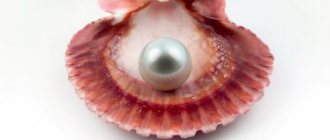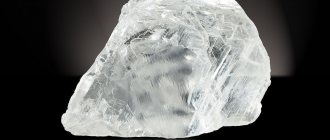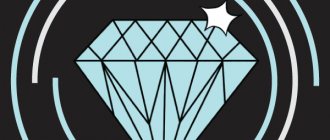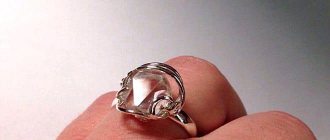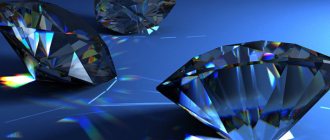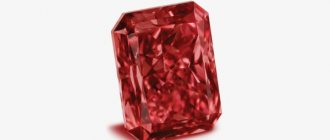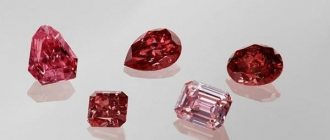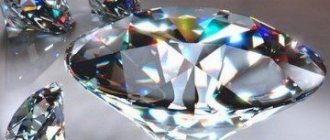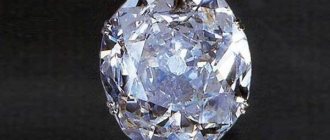“It remains unharmed in the strongest fire, it is the light of the sun, condensed in the earth and cooled by time, it plays with all colors, but itself remains transparent, like a drop of water...” These words were written long before the well-known phrase of Marilyn Monroe, but they do not lose relevance even today.
Needless to say, every woman would like to have diamond jewelry. The price of products with precious minerals, and primarily with cut diamonds, largely depends on the quality of the stone. Therefore, it is very important to be able to correctly decipher the characteristics indicated on the product tag.
Diamond grading system: 4 “C”
When conducting an expert assessment of a stone, a gemologist takes into account 4 mandatory criteria, called the 4 “Cs”.
The first parameter is carat weight (stone weight). As you know, the generally accepted measure of the mass of jewelry stones is a carat, equal to 0.2 grams. The word “carat” itself comes from the name of the pod tree, the seeds of which were originally used to measure minerals.
The second is color. To a layman, diamonds appear completely transparent, but in fact their shades vary.
The third parameter is clarity. The purity of a mineral is determined by the presence of inclusions in its composition, as well as their characteristics.
The fourth parameter is cut—the cut of the diamond.
It is these indicators that are the basis for determining the quality of the diamond and, accordingly, the cost of the entire product. And now first things first.
Diamond Excelsior (Excelsior)
Weight: 970 carats
The Excelsior was the largest diamond in the world until Cullinan's discovery in 1905. At the time of its discovery, this rough stone weighed 971 carats (about 194.2 grams) and was shaped like a leaf. It was discovered in the Jagersfontein mine in South Africa in the Northern Cape province.
In 1903, the diamond was cut into 11 pieces of different weights. The reason was that it was too big and expensive for any buyer.
At the time, the decision to split Excelsior into smaller pieces was widely criticized. Experts also opined that the diamond must have been cut to produce one of the largest diamonds.
In the 1990s, Excelsior I (69.68 carats) sold for approximately $2,642,000.
Let's decipher the characteristics
The certificate for set jewelry stones is a tag. It is on it that the main characteristics of diamonds are indicated, encrypted in a special code. Each code corresponds to either one or several identical stones fixed into the product.
The first number indicates the number of diamonds with identical characteristics.
This is followed by a code for the type of stone cut, which includes the letter designation of the diamond shape and the number of facets. Then the total carat weight of the stones with these characteristics set into the product is written. The next two numbers, indicated through a fraction, indicate the class of color and purity, respectively (according to Russian technical specifications). Next, the quality of the diamond cut is noted in accordance with the standard cut.
How much jewelry is acceptable to wear?
There are never too many diamonds, but they need to be worn correctly. For once, two or maximum three small decorations are enough. Combination options:
- ring plus bracelet;
- earrings – pendant/pendant;
- earrings - necklace;
- earrings, ring, brooch.
The brooch and pendant are incompatible.
Large necklaces or brooches are worn without other jewelry.
Necklace with diamonds
Diamonds do not tolerate proximity to other stones, even the highest class. Bad manners, for example, diamond earrings and a ruby brooch. A combination of gems is acceptable in one piece of jewelry. For example, diamonds and emeralds/rubies/sapphires/pearls in a necklace, brooch or other item.
Cut quality
At the beginning of the 20th century, Russian-born mathematician Marcel Tolkowsky published a study “Diamond Design”, in which he presented the proportions of an ideal diamond cut from the point of view of refraction of rays, which ensures maximum shimmer of light. Thus, round diamonds with 57 facets became known as “Tolkowsky diamonds” and were designated Kr-57. It is this type of cut that is called Russian all over the world and is considered the world standard.
For small diamonds, a round shape with 17 facets (Kr-17) is considered ideal. This cut allows you to maintain the most optimal ratio of the quality characteristics of the stone with its price.
In Russia, diamond cutting parameters are regulated by TU 117-4.2099-2002. The document indicates some geometric parameters of diamonds, according to which the stones are classified into one of four categories: from A to G. The highest quality cut, in which all recognized standard parameters are observed, is designated by the letter “A”. Thus, the diamonds in SOKOLOV jewelry have exactly this cut.
How to distinguish a diamond from moissanite
The fogging test can also be applied to moissanites, and this is the first thing that an artificial stone will reveal. If natural cubic zirconia does not exist in nature, this is the development of physicists, then with moissanites everything is more complicated. There are natural and synthetic stones. The artificial version of moissanite is more common, and stones weighing half a carat can be purchased for $100-150. A beautiful shine when cut correctly is brighter than a diamond, and the impeccable purity of moissanite, as befits synthetics, adds beauty. It also reveals the artificial origin of the stone. Even the shape of the cut does not affect the brightness and clarity.
| On the left is moissanite, on the right is diamond | On the left is moissanite, on the right is diamond |
It’s not easy to find jewelry with natural moissanite, and it’s not profitable for anyone to pass it off as a diamond – the prices per carat are almost equal. Natural moissanite with a diameter of more than 2 mm has not yet been found, and if you have a larger stone in front of you, it is definitely not natural moissanite, but whether it is a diamond or not needs to be examined separately. Remember? The easiest way is to breathe on the stone. The diamond will not fog up.
Like cubic zirconia, synthetic moissanite is often used as a companion to precious stones, and due to the brighter play of light, moissanite very favorably emphasizes the beauty of natural stones. This synthetic analogue of a diamond with corundum group gemstones looks especially beautiful.
| Moissanite framed with rubies | GT emerald and two moissanites | Sapphire and moissanites |
But any analog is just a replacement of the original, its imitation, and if there were any opportunity in the world to create an artificial stone that exactly replicates the properties of a diamond, its value would not be so high.
Diamond color
There are several shades of diamond. Some of them have differences that are so insignificant, in the eyes of the average person, that only an experienced gemologist can distinguish between them.
In Russia, the criteria for assessing the color of a diamond are regulated by TU 117-4.2009-2002. Shades of the stone vary from bluish-white to cognac and are designated by numbers from 1 to 9. Assessing color, like determining other characteristics of a diamond, is a painstaking process that requires the highly professionalism of a gemologist. This is evidenced by the terms “barely perceptible”, “brightly visible”, “insignificant shade”, etc. used in the technical specifications, on the basis of which a diamond is assigned to one or another color group.
In accordance with the current technical conditions, the color of diamonds with 17 facets, from 57 to 0.29 carats, and 57 facets from 0.30 carats is assessed differently. Therefore, the shade of a small 4th color crystal will be more saturated than the color of a larger 4th class diamond from 0.30 carats.
Among 17-sided stones, the most optimal in terms of price and quality are considered to be group 2 diamonds (“with a subtle tint” or “with a slight yellow tint”). And for larger crystals with 57 faces, this is color class 3. According to the American GIA system (from the name of the Gemological Institute of America), these numbers correspond to the designations F, G and H.
Color scale for diamonds of different sizes
| Description | Diamond color group | ||
| Kr-17 | Kr-57 | ||
| up to 0.3ct | from 0.3ct | ||
| Bluish white | 1 | 1 | 1 |
| With a subtle tint | 2 | ||
| 2 | 2 | 3 | |
| With a slight yellow tint | 3 | 4 | |
| With a little tint | 3 | 5 | |
| White, with visible color tint | 4 | 6 | |
| With a brightly visible color tint | 7 | ||
| Yellow | 5 | 8-1 — 8-5* | |
| Brown color | 4 | 6 | 9-1 — 9-4* |
| 7 | |||
*The second number after the main one indicates the color intensity in one color group.
Top 20 most expensive and dazzlingly beautiful diamonds
Diamonds are the most unsurpassed and expensive stones. We have selected for you twenty “best friends of girls” that will be difficult to take your eyes off.
Get acquainted with a selection of the most beautiful and expensive diamonds in the world, the brilliance of which is truly dazzling. Let's start with the bottom step of our top.
Moussaieff Red Diamond
The rarest red diamond was discovered by a Brazilian farmer in 1990. It was recognized as the largest red diamond. This gemstone weighs 5.11 carats and has an estimated value of over $7 million.
Diamond Elizabeth Taylor
The world-famous actress received a luxurious diamond ring as a gift in 1968, which was subsequently sold at auction in 2011 for $8.8 million.
Diamond Taj Mahal
The luxurious Taj Mahal diamond in the shape of a heart in a gold frame was bought for $8.8 million at auction.
Brooch of Empress Eugenie
A brooch of unique beauty, studded with diamonds and framed in silver and gold, belonged to the wife of Napoleon III. Experts estimated its cost at $10.5 million.
Diamond Sundrop
This truly huge yellow diamond of 110.03 carats was sold in 2011 in Geneva for $12.4 million. It is distinguished by its unique purity, transparency and record weight for natural diamonds.
Diamond Fancy bright blue
The 8.01-carat emerald-cut bright blue diamond is a rare specimen. In 2012, it was sold at a Hong Kong auction for $12.8 million.
Diamond Pink Clark
Another rare 9-carat single-color diamond was purchased at auction by the owner of one of the largest corporations for $15.7 million.
Diamond Chloe
An 84.37-carat colorless, transparent diamond of uniquely rare clarity and perfectly cut. In 2007, this stone of the highest quality was sold for a huge amount of money at that time - 16.2 million dollars.
Diamond Graff Vivid Yellow
In May 2014, a huge and beautiful yellow diamond called Graff Vivid Yellow was purchased at a Geneva auction for $16.5 million. Its weight at the time of sale was 100.09 carats.
Diamond Star of the Season
The colorless and transparent diamond, shaped like a pear, weighs 100.1 carats. It was bought at a Geneva auction in 1995 by a jewelry collector, a sheikh from Saudi Arabia, for $16.5 million. Moreover, after the end of the auction, a significantly larger amount was offered for it, but the true collector rejected this offer.
Diamond Martian pink
This diamond is one of the rarest pink diamonds, weighing 12.04 carats, and it was bought at auction in Hong Kong by a buyer who wished to remain anonymous for $17.4 million.
Diamond Archduke Joseph
The oldest diamond of the highest quality, 76.02 carats, was sold in 2012 at a Geneva auction for $21.48 million to an anonymous buyer. The stone was first registered with its original owner almost a hundred years ago in 1919, during which time it was sold several times, and the last date of sale was recorded in 2012.
White emerald cut diamond
This gorgeous white diamond weighs 100 carats and its clarity can be compared to pure spring water. In 2015, the gem was sold to an anonymous telephone buyer for $22.1 million.
Diamond Perfect Pink
A 14.23-carat natural pink diamond set in a ring sold for an Asian record price at an auction in Hong Kong for $23.2 million.
Diamond Legacy Winston
The clear and colorless pear-shaped diamond is one of the largest diamonds ever offered at auction. Its weight is 101.73 carats. In 2013, it was bought by a jewelry store for $26.7 million, so the diamond was named after its owner.
Blue Diamond De Beers Millennium
A heavenly-colored diamond of the highest quality, 10.1 carats, was purchased in Hong Kong in 2016 for $30 million.
Diamond Pink Graff
The quadrangular pink diamond in the ring was sold in 2010 to the famous jeweler-collector Laurence Graff for $46.16 million.
Mouawad L'Incomparable
One of the most expensive diamond necklaces in the world, which was even included in the Guinness Book of Records, is valued at $55 million. The weight of the 103 diamonds present on it is 637 carats.
Diamond Pink Star
This diamond is considered the most expensive pink diamond with a record weight for its variety - 59.6 carats. In 2013, this gem broke all diamond price records and was sold at Sotheby's for a fabulous $83 million. Later it became known that the buyer was unable to buy the stone and Sotheby's bought it for itself for $72 million.
Wittelsbach-Graff Diamond
The winner of our rating, the most expensive and beautiful diamond in the world, was the 31-carat Wittelsbach-Graff blue diamond, which in 2011 was sold at auction for $80 million.
Diamond Clarity
Just like determining the color of a stone, assessing its clarity does not occur the same for all diamonds. Russian specifications describe in detail the nature of inclusions (their volume, quantity, location, etc.) that influence the classification of a diamond into a specific clarity class.
For Kr-17 diamonds used in jewelry, the optimal clarity groups are 2 and 3. For Kr-57 up to 0.29 carats these are groups 4 and 5, and for larger diamonds with 57 facets - 4-6.
It is important to consider that the groups have a fairly wide range. In simple words: five five different. Therefore, do not rush to conclusions if you see a cleanliness class that is too “low,” in your opinion. In this case, it is better to check with the jewelry manufacturer for more detailed information about diamond suppliers, cutting features and other aspects that affect the quality of the stone.
Diamond Clarity
| Characteristics of purity groups | Diamond Clarity Group | |||
| KR-17 | KR-57 | GIA | ||
| Up to 0.29ct | From 0.29ct | |||
| Without defects | 1 | 1 | 1 | IF |
| Defects: one bright point in the central zone, visible only when viewed from the pavilion; no more than two subtle light dots or one subtle stripe in the middle or peripheral zone | 2 | 2 | 2 | WS-1 |
| Defects: no more than three minor light spots in the central area; no more than two defects in the form of minor dark dots or stripes in the middle and peripheral zones | 3 | 3 | WS-2 | |
| Defects: no more than two minor dark spots in the central part; no more than four small light dots, no more than two stripes or one strip and three small light dots in any zone; minor crack in the peripheral area | 4 | |||
| Defects: one small light cloud or one small crack in the central zone or no more than six defects in the form of small light stripes; no more than three minor cracks in the middle and peripheral zones | 3 | 4 | 5 | VS-1 |
| VS-2 | ||||
| Defects in any zones: no more than eight small scattered light defects in the form of dots, stripes, small cracks, bubbles, microseams and growth lines, or up to five small dark dots, or one minor graphite inclusion | 5 | 6 | SI-1 | |
| Defects in any zones: no more than eight small scattered defects (including those faintly visible to the naked eye) in the form of dots, stripes, small cracks, dust clouds or one small graphite inclusion | 7 | |||
| Numerous defects in any zones: no more than two small graphite inclusions, or no more than two small cracks, or no more than one small cloud in combination with a graphite inclusion, or one small crack in combination with a graphite inclusion, or several small cracks in combination with graphite turning on | 7a | SI-2 | ||
| SI-3 | ||||
| Numerous defects in any zones: except for graphite inclusions, including in the form of cracks visible to the naked eye | 4 | 6 | 8 | I-1 |
| Numerous defects in any zones: in the form of graphite inclusions or graphite inclusions in combination with cracks visible to the naked eye | 9 | I-2 | ||
| Defects in any zones: of various types, visible to the naked eye, transparent for viewing at least 60% of the diamond pavilion facets | 7 | 10 | ||
| Defects in any zones: of various types, visible to the naked eye, less than 60% of the diamond pavilion facets are transparent for viewing | 5 | 8 | 11 | I-3 |
Assortment of jewelry
The jewelry market offers diamond jewelry for different tastes and budgets.
Earrings
When choosing a product, take into account the age, face type, and hair color of the owner.
Diamond earrings
Earring models:
- hanging - for an evening or cocktail party;
- rings - youth non-working option;
- paths are classics, appropriate for any occasion;
- studs – youth or office option.
Hair should not cover the earrings, so a high hairstyle or short haircut is preferable:
- studs are organic with short hair;
- Long models or massive ones of medium length are suitable for hair pulled up.
Dangling earrings go well with a round face, and studs or rings go well with an oval face.
Ring
The choice of ring depends on the age of the owner and the occasion:
- Solid jewelry is the prerogative of mature ladies and is worn for evening events.
- A ladies' ring with a diamond is designed for the ring finger, or, alternatively, the middle or index finger.
- Men's signet rings are worn randomly.
A diamond ring symbolizes engagement and is worn to show that marriage is just around the corner.
Other rings next to him, even diamond ones (except for the wedding ring) are inappropriate.
Pendant, pendant
The mini format is suitable for daily wear. The length of the chain is determined by the neckline of the garment. If the dress has a turtleneck, the size is arbitrary.
Diamond pendant
Pendants go well with stud earrings. With a light blouse, classic trousers, and a pencil skirt, they create a feminine and moderately official image.
Bracelets, watches
Watches from top brands, encrusted with diamonds, are a status accessory for men and women.
The bracelet should move on your hand. But if the stones make up a composition, the product is fixed tightly.
Brooch
A decoration that makes the image elegant and complete. Attaches to a collar, scarf, handbag, hat. Not worn on outerwear.
Types of brooches:
- pin - a choice for all occasions, easily and securely attached to a scarf, clutch, handbag, jacket lapel;
- hairpin is a two-in-one product: suitable for clothes and hair;
- needle - a weightless, sophisticated option; ideal for a hat.
Massive jewelry is placed under the throat or closer to the neck, graceful - 10-15 cm below the shoulder or collar.
Brooch with diamonds
A non-trivial solution - a brooch on a belt with a high waist.
Necklace
A diamond necklace is the height of chic and luxury. The number of stones and the style of the frame determine the scope of use of the jewelry:
- made entirely of diamonds, worn in the evening, with a chic low-cut dress;
- abstraction, floral motifs are chosen for an evening or cocktail;
- strict geometry is appropriate for a business or official event.
A necklace with sapphire inserts goes with a blue or white outfit, and with emerald inserts it goes with white, black, and green.
Diamonds plus natural pearls are an aristocratic option for jewelry.
| Property | Description |
| Formula | C |
| Color | Colorless, yellow, brown, blue, light blue, green, red, pink, black. |
| Shine | Diamond |
| Transparency | Transparent |
| Hardness | 10 |
| Cleavage | Perfect by {111} |
| Kink | Conchoidal to splintery |
| Density | 3.47-3.55 g/cm³ |
Frame color
Rose or yellow gold is a classic choice for blondes. Brunettes will be adorned with items made of platinum or white gold with a diamond: they will stand out against the background of dark hair.
Men's products
The number one accessory for successful men is a branded watch made of titanium or platinum.
Jewelry with large black diamonds is popular: cufflinks, tie pins, signet rings, rings made of platinum or white gold. The design is ascetic classic.
Black diamonds
In recent years, jewelry with black diamonds has come into fashion. Some people mistakenly believe that these minerals are low-grade.
The cost of black diamonds is indeed much lower, but they are rarer. Thanks to this, jewelry with them is often considered exclusive. When selecting black diamonds, the color saturation of the stone, uniformity of color, and absence of chips and cracks are taken into account.
Choose diamond jewelry wisely and delight yourself and your loved ones with precious gifts.
Modern Diamond Etiquette
Diamonds can be worn by everyone – depending on age, occasion, wardrobe.
Age
The general rule for jewelry applies to diamonds: the younger the owner, the smaller the stones and the more elegant the setting of the jewelry. Young people like a miniature pendant, pendant, studs, brooch with small stones or diamond chips. The prerogative of a respectable lady is accessories with a large diamond.
Times of Day
A diamond is considered an evening stone when its brilliance is at its maximum. However, if there are no evening receptions planned, you can wear diamond accessories during the day.
The following must be taken into account:
- during the day they wear elegant jewelry with small or small stones in white gold;
- Larger diamonds, colored ones, in solid platinum or gold of other colors are intended for evening.
Diamond earrings Jewelry
acceptable at work:
- stud earrings or slightly dangling earrings with small or small stones;
- a ring in an unobtrusive frame with the same insert;
- miniature pendant.
Bracelets, necklaces, dangling earrings, imitation of zodiac constellations, brooches are prohibited (an elegant abstraction or a twig is acceptable).
One product is enough for the office.
Wardrobe
Diamond jewelry requires clothing of the appropriate level. This could be a little black dress, a classic business suit, or a blouse in muted tones. But things must be of high quality, preferably branded.
Diamonds are incompatible with sportswear, denim, folk, casual clothing, and knitted items. Colourfulness is prohibited.
How to distinguish a diamond from rock crystal
This stone has no jewelry value; the mineral is an ordinary variety of quartz and has its same properties. The purity of crystals is the main disadvantage of rock crystal, since the mineral does not have it, and samples with high transparency are rare. However, as in the case of cubic zirconia, you can look through the rock crystal into light and recognize contrasting text or images. The stones can be identified by their cloudy girdle (remember, this is a cut in the middle along the entire circumference), they are characterized by a “gassed” effect - when examining the mineral, you can notice clusters of tiny inclusions.
| You can see the background behind the mineral | Opaque girdle | Lots of small inclusions |
In addition, rather large minerals are used in rock crystal jewelry, and the stones themselves can be recognized by their characteristic, barely noticeable “haze” inside.
